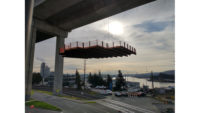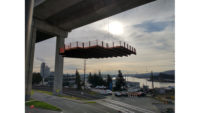The field trial of a mineral-based concrete binder as a replacement for portland cement shows promise, says structural engineer Don Davies, the developer of a living laboratory in Seattle to prove the efficacy of bleeding-edge reduced-carbon materials.
The structural engineer-turned-developer showcased C-Crete Technologies’ zeolite-based binder in a 20-ton outdoor slab-on-grade, cast on Nov. 16, at the 5,126-sq-ft Hubbard’s Corner seismic retrofit. Davies is excited about the implications of concrete containing C-Crete’s zeolite binder, which he says was batched from a ready-mix truck, pumped and finished using normal construction procedures.
“We are over 4,500 psi with cylinder breaks at 28 days, and [the slab] is still getting stronger,” says Davies, a founding principal of developer-sustainability consultant Davies-Crooks Associates and chair of the nonprofit Building Transparency, which supports construction industry efforts to address embodied carbon’s role in climate change.
As with other portland cement-free mixes, there is very little heat generated during curing, says Davies. “This means it will be great in hot weather applications, but it is slower to set and cure in the cold,” he adds.
Second C-Crete Debut
This was Hubbard’s second debut of a C-Crete product. Earlier this year, crews cast about 100 tons of concrete containing C-Crete Cement, which uses blast-furnace slag as a binder, as part of the demonstration building’s concrete structure.
The C-Crete zeolite mix behaved similarly to the slag mix, Davies says.
Zeolites are plentiful “hydrated aluminosilicate minerals that contain alkali and alkaline-earth metals,” according to the Encyclopaedia Britannica. “Natural zeolites occur in volcanic rocks as cavity fillings.” They also are in sedimentary rocks on land and in the ocean.
There are “billions of tons” of the naturally occurring zeolite available in California alone, says Rouzbeh Savary, founder and president of C-Crete Technologies, a building materials-science startup based in San Leandro, Calif. The zeolite rock for the Hubbard’s project was sourced from Zeolite Composites LLC, he adds.
C-Crete’s zeolite-based concrete has more than 5,000-psi compressive strength, says C-Crete. It flows and pumps like conventional concrete and meets the industry standards set by ASTM International for mechanical and durability properties, such as expansion and freeze-thaw resistance.
C-Crete offered the material to the Hubbard's Corner project at a comparable price to normal portland cement, says Davies. "Our cost delta has not been in the base material, it has been in the handling of a different material through the batch plant, and the mark-up and testing that the batch plant may place on being asked to do something different," he adds.
There is an early-adopter case-by-case cost premium today, which should go away with time, Davies continues. "The same can be said for many of the newer next-generation lower carbon supplementary or alternative cement materials starting to be considered," he says.
Savary says the zeolite binder does cost more, at least for the time being. When production is scaled up, the cost of the binder will eventually match the cost of portland cement, he says. “At small scales, any manufacturing is sub-optimal and cost is more,” he adds.
C-Crete is currently in discussions with potential industrial partners for a large-scale plant, which would produce about 1 million tons per year, as do most portland cement plants. C-Crete’s zeolite pilot plant has a capacity of about 1,000 tons per year.
Cautiously Optimistic
Other concrete specialists are cautiously optimistic about emerging binders. “Developing novel binders is an important and promising pathway to lower embodied-carbon concrete,” says Dirk Kestner, senior principal and director of sustainable design at structural engineer Walter P Moore. “We need a life-cycle assessment or an environmental product declaration to quantify the inputs” related to production, he adds. “We also need durability tests.”
Andreas Tselebidis, chief engineering, research and development officer for Smyrna Ready Mix Concrete LLC has a similar take on portland cement-free binders. For massive foundations, he is concerned about “workability performance over time during the placement, the durability aspects of the concrete and the engineering properties over time under loading.
“We need to understand the limitations,” says Tselebidis. Still, the zeolite binder is “a step” toward C-Crete’s goal of more-sustainable concrete, he says.
Other recent steps are two grants to C-Crete from the U.S. Dept. of Energy. In October, DOE awarded C-Crete $2 million to “demonstrate the feasibility of converting greater than 10 kg per day of CO2 to a special formulation of high-performance concrete that rivals or outperforms portland cement concrete while mineralizing net CO2.”
The material under development is intended to be a fast-curing and carbon-negative concrete with high strength and toughness that uses low manufacturing energy, according to C-Crete.
In September, DOE awarded C-Crete $950,000 to expand the types of materials for the production of portland cement-free concrete, using local feedstocks. Local feedstocks are attractive because they would eliminate long-distance shipping, says C-Crete.






Post a comment to this article
Report Abusive Comment